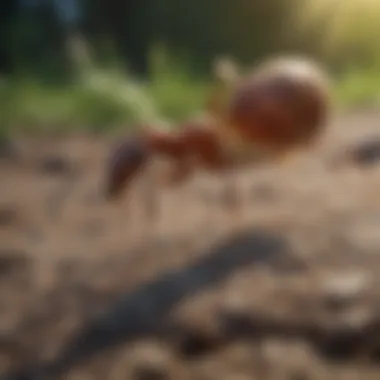Discover the Most Effective Ant Control Products: A Complete Guide


Preventive Pest Control Strategies
Preventive pest control strategies are crucial in maintaining a pest-free environment within your home. By incorporating these methods into your routine, you can effectively mitigate the risk of pest infestations. Here are some key strategies to consider:
- House Exterior Protection: Ensuring the exterior of your house is well-sealed is essential in preventing pests from entering. Be sure to seal cracks and crevices where ants and other pests may find entry points. Clearing debris such as leaves and woodpiles from around your home can also help deter pests.
- Yard Maintenance: Proper yard care is an integral part of pest prevention. Regularly mowing the lawn, trimming bushes, and eliminating standing water can significantly reduce the likelihood of pests taking up residence in your yard.
- Indoor Cleanliness: Maintaining a clean indoor environment is key to preventing pests from finding food and shelter in your home. Expert cleaning tips can help you keep your home pest-resistant, ensuring that ants and other unwanted visitors stay away.
- Garbage Disposal: Proper waste disposal methods are essential in preventing pests from being attracted to your home. Be sure to dispose of garbage regularly and keep trash bins tightly sealed to minimize the risk of infestations.
- Other Pest Prevention Strategies: In addition to the above measures, there are innovative ways to safeguard your home against pests. Consider implementing strategies such as using natural deterrents or installing pest-resistant landscaping to further enhance your pest control efforts.
By implementing these preventive pest control strategies, you can create a robust defense against ants and other common household pests.
Understanding Ant Infestations
Common Ant Species
Carpenter Ants
Carpenter ants play a significant role in the realm of ant infestations. Their penchant for tunneling through wood, though not for consumption like termites, can lead to substantial structural damage over time. Recognizable by their large size and typically nocturnal activity, carpenter ants present a unique challenge in ant control efforts. Their ability to establish satellite colonies complicates eradication processes, requiring targeted strategies for effective management within the scope of this comprehensive guide.
Odorous House Ants
Odorous house ants, named for the pungent smell they emit when crushed, are among the most common household ants. While not known to pose significant structural threats, their presence can be persistent and bothersome. Understanding their foraging patterns and nesting preferences is key to developing tailored ant control approaches. Despite their nuisance factor, odorous house ants offer an intriguing study in community dynamics and foraging behavior, underscoring the importance of comprehensive pest management.
Fire Ants
Fire ants, infamous for their painful stings and aggressive behavior, are a crucial focal point in ant control discussions. Their ability to form large colonies with multiple queens presents a formidable challenge in eradicating infestations effectively. Sensitive to disturbances, fire ants exhibit unique defensive behaviors that impact control measures. Strategies aimed at disrupting their reproductive cycles and colony organization are essential for successful fire ant control, making them a pertinent inclusion in this all-encompassing guide.
Pharaoh Ants
Pharaoh ants, known for their resourcefulness and adaptability, are a difficult adversary in ant control endeavors. Their small size and prolific breeding rate make them challenging to eliminate completely. Pharaoh ants' preference for warm, humid environments aligns with many household settings, necessitating meticulous attention to detail in eradication efforts. Their impact on food safety and potential health risks further emphasize the importance of targeted solutions and proactive management in combating these resilient pests within the context of this comprehensive guide.
Behavior and Habits
Foraging Patterns
Foraging patterns play a crucial role in understanding and managing ant infestations effectively. By studying how ants search for food and communicate their findings back to the colony, individuals can devise strategic baiting and trapping methods. Understanding the types of food sources that attract ants enables homeowners to proactively mitigate infestations. By uncovering the intricacies of foraging patterns, one can tailor ant control strategies to disrupt this essential activity, forming a cornerstone of pest management efforts.
Nesting Preferences
Nesting preferences shed light on the intricacies of ant colonies' inner workings and structures. By comprehending where ants choose to build their nests and rear their young, individuals can target these key areas for eradication. Identifying and destroying nesting sites is essential for eradicating ant populations at the source, preventing recurrent infestations. Successfully thwarting ants' nesting tendencies is a crucial step in achieving long-term ant control results and safeguarding homes against future invasions.
Dietary Needs
Ants' dietary needs influence their foraging behavior and colony dynamics, playing a pivotal role in devising effective ant control methods. By understanding the dietary preferences of different ant species, homeowners can deploy baiting systems tailored to attract and eliminate specific ant populations. Considering the nutritional requirements of ants enables individuals to select control products that disrupt their dietary patterns, leading to more targeted and efficient eradication. Addressing ants' dietary needs forms a critical component of integrated pest management strategies detailed in this comprehensive guide.
Risks of Ant Infestations
Property Damage


Unchecked ant infestations pose significant risks to property structures and integrity. Carpenter ants, in particular, can wreak havoc on wooden elements within a home, compromising its stability and value over time. Regular inspections and proactive ant control measures are essential in averting costly repair bills and structural issues caused by ant damage. By emphasizing the potential for property damage in the wake of ant infestations, individuals are motivated to adopt comprehensive control strategies outlined in this guide for preventative measures.
Health Concerns
Ant infestations can lead to various health concerns, ranging from allergic reactions to the spread of pathogens within living spaces. Fire ants, with their aggressive behavior and stinging mechanisms, pose immediate health risks to humans and pets. Understanding the health implications of ant presence underscores the importance of swift and effective control measures. By addressing health concerns proactively through ant control solutions, individuals can safeguard against potential injuries and illnesses associated with ant infestations, ensuring a safe and healthy living environment.
Impact on Food Safety
Ant infestations can have a detrimental impact on food safety within residential settings. Odorous house ants, drawn to sugary substances and crumbs, pose contamination risks to pantry staples and food preparation areas. Maintaining hygienic conditions and barrier protections against ants are essential for preserving food safety standards. By elucidating the risks of compromised food safety due to ant infestations, individuals are motivated to implement stringent control protocols and product recommendations detailed in this comprehensive guide, mitigating potential foodborne illness threats.
Types of Ant Control Products
Ant control products play a vital role in managing ant infestations effectively. Whether dealing with common ant species like Carpenter Ants, Odorous House Ants, Fire Ants, or Pharaoh Ants, having the right products is crucial. In this article, we will explore various types of ant control solutions, from natural remedies to traditional insecticides and electronic repellents, offering a holistic approach to pest management.
Natural Solutions
Diatomaceous Earth
Diatomaceous Earth is a natural product that works by dehydrating ants upon contact. Its key characteristic lies in its non-toxic nature, making it a safe yet effective choice for ant control. The unique feature of Diatomaceous Earth is its mechanical mode of action, which damages the waxy exoskeleton of ants, leading to dehydration and eventual death. Its advantage in this article is the eco-friendly and non-toxic approach it provides, ideal for households looking for natural ant control methods.
Peppermint Oil
Peppermint oil is a potent essential oil known for its strong scent that repels ants. Its key characteristic includes its natural repellent properties, deterring ants from entering spaces. The unique feature of Peppermint Oil is its dual function as both an ant repellent and a fresh-smelling agent. Its advantage lies in being a natural and non-toxic alternative for ant control in homes, ensuring a pleasant environment without harmful chemicals.
Vinegar
Vinegar is a versatile household product that serves as a natural ant deterrent. Its key characteristic is its acidic nature, which disrupts ant trails and communication. The unique feature of Vinegar is its dual action as a cleaning agent and ant repellent. Its advantage in this article is the cost-effectiveness and availability, making it a convenient choice for combating ant infestations naturally.
Traditional Insecticides
Sprays
Sprays are a common form of traditional insecticides used to directly target ants on contact. Their key characteristic lies in their quick-killing action, offering immediate results upon application. The unique feature of sprays is their ease of use and suitability for targeting specific ant sightings. Their advantage in this article is the rapid response they provide, making them efficient in controlling ant populations in indoor spaces.
Granules
Granules are insecticidal particles designed to be spread around ant trails and entry points. Their key characteristic is their residual effect, creating a barrier that continues to eliminate ants over time. The unique feature of granules is their extended protection, offering long-term ant control benefits. Their advantage in this article is the targeted application for outdoor spaces, ensuring thorough coverage and sustained efficacy.
Baits
Baits are baited stations or gel formulations that attract ants to consume poisoned bait, eventually leading to colony eradication. Their key characteristic lies in their slow-acting poison, allowing ants to carry the toxic bait back to their nests. The unique feature of baits is their stealthy approach to ant eradication, targeting the entire colony for long-lasting results. Their advantage in this article is the comprehensive solution they provide, addressing both visible ant populations and hidden nests for effective control.
Electronic Repellents
Ultrasonic Devices


Ultrasonic devices emit high-frequency sound waves that disrupt ant communication and foraging patterns. Their key characteristic is their non-intrusive method of repelling pests without chemicals. The unique feature of ultrasonic devices is their continuous operation, creating a hostile environment for ants without human intervention. Their advantage lies in their pet-friendly and eco-conscious approach, offering a modern solution to ant infestations without environmental repercussions.
Electromagnetic Pest Control
Electromagnetic pest control devices alter the electromagnetic field within walls, disturbing pests like ants. Their key characteristic lies in their ability to target pests hidden in wall voids or inaccessible areas. The unique feature of electromagnetic pest control is its coverage of larger indoor spaces, creating a whole-home protection zone. Their advantage in this article is the seamless integration into household electrical systems, providing constant pest deterrence without physical barriers.
Factors to Consider When Choosing Ant Control Products
In the realm of effective ant control products, selecting the most suitable option requires careful consideration of various factors. Effectiveness, Application Method, and Safety Considerations play pivotal roles in choosing the right product. The efficiency of an ant control product is determined by its ability to exterminate ants promptly, provide long-term residual effects, and target specific ant species without harming beneficial ones. Moreover, ease of use, whether the product is ideal for indoor or outdoor application, and the necessary safety precautions are all critical aspects that influence the decision-making process.
Effectiveness
Immediate Killing Action
Immediate Killing Action is a fundamental aspect of ant control products as it dictates how swiftly and decisively the product can eliminate existing ant populations. A product with immediate killing action means that it starts working upon contact with ants, swiftly eradicating them before they can cause further harm. This feature is highly advantageous for combating sudden infestations as it provides quick relief. However, products with such quick-action formulations might have to be reapplied more frequently to maintain control.
Long-Term Residual Effects
Long-Term Residual Effects are crucial for maintaining a pest-free environment over an extended period. Ant control products with this attribute continue to be effective even after the initial application, offering protection against new ant invasions. This feature is beneficial for areas prone to recurrent ant infestations, ensuring sustained control without the need for frequent reapplication. However, it is essential to follow manufacturer guidelines to maximize the longevity of these residual effects.
Targeted Species
Ant control products that can specifically target certain ant species are immensely beneficial in tackling infestations with precision. By focusing on the specific species causing problems, these products minimize collateral damage to other beneficial insects. Products tailored for targeted species often contain ingredients or mechanisms that only affect the identified pests, leaving non-target organisms unharmed. However, identifying the exact ant species infesting your property is crucial for selecting the right targeted product.
Application Method
Ease of Use
Ease of Use is a critical aspect that influences the practicality and convenience of an ant control product. Products that are user-friendly, with clear instructions and straightforward application methods, make the process more manageable for consumers. The simplicity of application enhances the overall efficacy of the product, ensuring that it can be readily deployed when needed. Factors such as ease of storage, minimal preparation requirements, and intuitive application procedures contribute to the product's appeal.
Indoor vs. Outdoor Application
The distinction between Indoor vs. Outdoor Application is essential when selecting an ant control product to address infestations effectively. Some products are suitable for indoor use, providing safe and efficient solutions for ant problems within the premises. Conversely, outdoor applications require products formulated to withstand environmental factors and pest pressure typically encountered outdoors. Distinguishing between indoor and outdoor use helps optimize the product's performance and ensure targeted control in specific settings.
Safety Precautions
Safety Precautions are paramount considerations when utilizing ant control products to safeguard households and the environment. Products with effective pest control capabilities should also prioritize the safety of humans and pets. Understanding and adhering to safety instructions, using protective gear when necessary, and storing products securely all contribute to a secure application process. While combating ant infestations, maintaining a balance between efficacy and safety is crucial to protect both residents and the ecosystem.
Safety Considerations
Pet and Child-Friendly Formulas
Ant control products formulated with Pet and Child-Friendly Formulas offer a humane approach to pest management without compromising the safety of vulnerable family members. These formulations prioritize ingredients and application methods that are safe for pets and children, minimizing the risks associated with toxic exposure. Such products provide peace of mind for households with pets or young children, allowing for effective pest control while maintaining a safe living environment.
Toxicity Levels


Understanding the Toxicity Levels of ant control products is essential to make informed decisions about their usage. Products with lower toxicity levels pose fewer risks to the environment, wildlife, and human health. By opting for products with reduced toxicity, consumers contribute to sustainable pest management practices while minimizing potential harm to beneficial organisms. Proper disposal of empty containers or leftover product further mitigates environmental impact, ensuring responsible utilization of ant control solutions.
Environmental Impact
Considering the Environmental Impact of ant control products is integral to promoting eco-friendly pest management strategies. Opting for products with minimal environmental consequences, such as biodegradable formulations or eco-friendly packaging, helps minimize the carbon footprint associated with pest control activities. Furthermore, assessing the long-term effects of these products on local ecosystems and biodiversity aids in making environmentally conscious choices that align with sustainable living practices.
Top Recommended Ant Control Products
In this article on effective ant control products, the section on top recommended ant control products holds significant importance as it narrows down the highly effective solutions for combating ant infestations. These top picks have been meticulously selected based on their proven track record, ease of use, and safety considerations to provide readers with a reliable arsenal against these pesky insects.
Product 1: Ant Killer Spray
Features
Delving into the features of the ant killer spray, it showcases a potent formula designed to swiftly eradicate ants on contact. The key characteristic lies in its fast-acting formulation, ensuring immediate elimination of ants upon application. This makes it a popular choice for those seeking quick and efficient results in their battle against ant invasions. Additionally, the unique feature of residual protection offers long-lasting effects, preventing future infestations. However, it is essential to consider any potential drawbacks such as strong odor or chemical ingredients that may not align with eco-friendly preferences.
Application
When it comes to application, the ant killer spray stands out for its ease of use, allowing effortless targeting of ant trails, nests, and entry points. Its user-friendly design makes it a convenient option for both indoor and outdoor use, providing flexibility in combating ant infestations. The unique feature of a precision nozzle ensures accurate application, minimizing wastage and maximizing effectiveness. Despite its convenience, users should be aware of any safety precautions during application, especially in households with pets or children.
Effectiveness
The effectiveness of the ant killer spray lies in its ability to swiftly eliminate ants and disrupt their colonies. Its key characteristic of rapid action ensures immediate results, bringing relief to households plagued by ant infestations. Users can benefit from the unique feature of targeted application, reducing chemical exposure in non-infested areas. However, while highly effective, it is essential to weigh the potential disadvantages such as chemical impact on the environment and the need for repeat applications in severe infestation cases.
Product 2: Ant Bait Stations
Composition
Exploring the composition of ant bait stations, they offer a strategic blend of attractants and insecticides to lure and eliminate ants. The key characteristic lies in their dual-action approach, enticing ants to consume the bait while delivering a lethal dose to decimate colonies. This effective method has made ant bait stations a popular choice for those seeking a comprehensive solution to their ant problems. However, users should be mindful of any disadvantages, such as potential toxicity to non-target organisms.
Placement Tips
When it comes to placement tips, strategic positioning of ant bait stations is crucial for optimal results. Highlighting key areas where ant activity is high enhances the chances of bait acceptance and colony elimination. The unique feature of weather-resistant design allows for outdoor placement, targeting ant trails and colonies effectively. While placement tips significantly enhance the bait stations' effectiveness, users should consider potential drawbacks like attractant odor or accessibility to pets and children.
Results
The results delivered by ant bait stations are highly commendable, with noticeable reductions in ant populations over time. Their key characteristic of long-lasting effects ensures continuous protection against new ant invasions, providing peace of mind to homeowners. The unique feature of colony elimination sets them apart from traditional insecticides, offering a sustainable approach to ant control. However, users should be cautious of unintended consequences such as secondary poisoning of beneficial insects or pets if ingested.
Product 3: Organic Ant Repellent
Ingredients
Diving into the ingredients of organic ant repellent, it harnesses the power of natural compounds like essential oils and plant extracts to deter ants effectively. The key characteristic lies in its eco-friendly formulation, making it a popular choice for those prioritizing sustainability and non-toxic solutions. The unique feature of safe ingredients ensures pet-friendly and child-safe usage while delivering robust ant-repelling properties. However, users should be aware of any limitations such as shorter efficacy periods compared to chemical repellents.
Application Instructions
When it comes to application instructions, organic ant repellent shines in its simplicity and versatility. Highlighting clear directions for use, including spraying around entry points and ant trails, ensures optimal protection against ant intrusions. The key characteristic of non-staining formula promotes hassle-free application on various surfaces without leaving unsightly marks. The unique feature of continuous protection with regular reapplication enhances its effectiveness, albeit requiring more frequent treatments compared to synthetic repellents.
Sustainability Benefits
The sustainability benefits of organic ant repellent are profound, offering a greener alternative to conventional insecticides. Its key characteristic of minimal environmental impact aligns with eco-conscious individuals seeking eco-friendly solutions. The unique feature of biodegradable ingredients ensures minimal residue accumulation in the environment, promoting ecological harmony. While sustainability benefits resonate with environmentally aware consumers, potential disadvantages such as shorter shelf life or higher costs due to premium ingredients should be taken into consideration.



